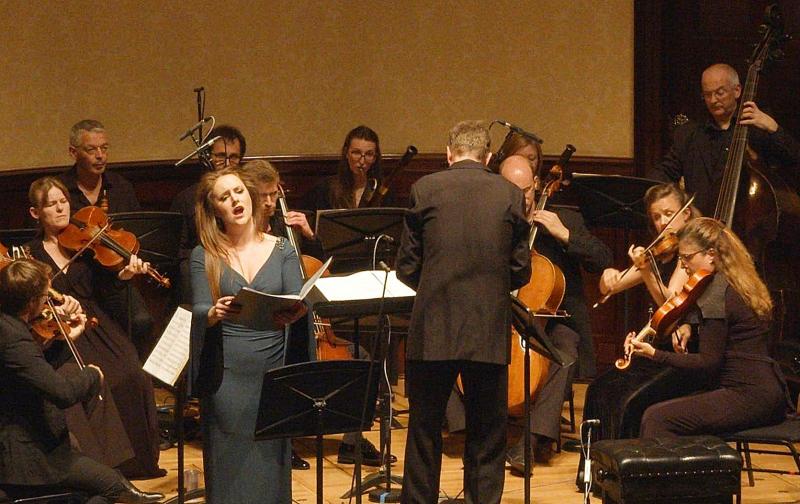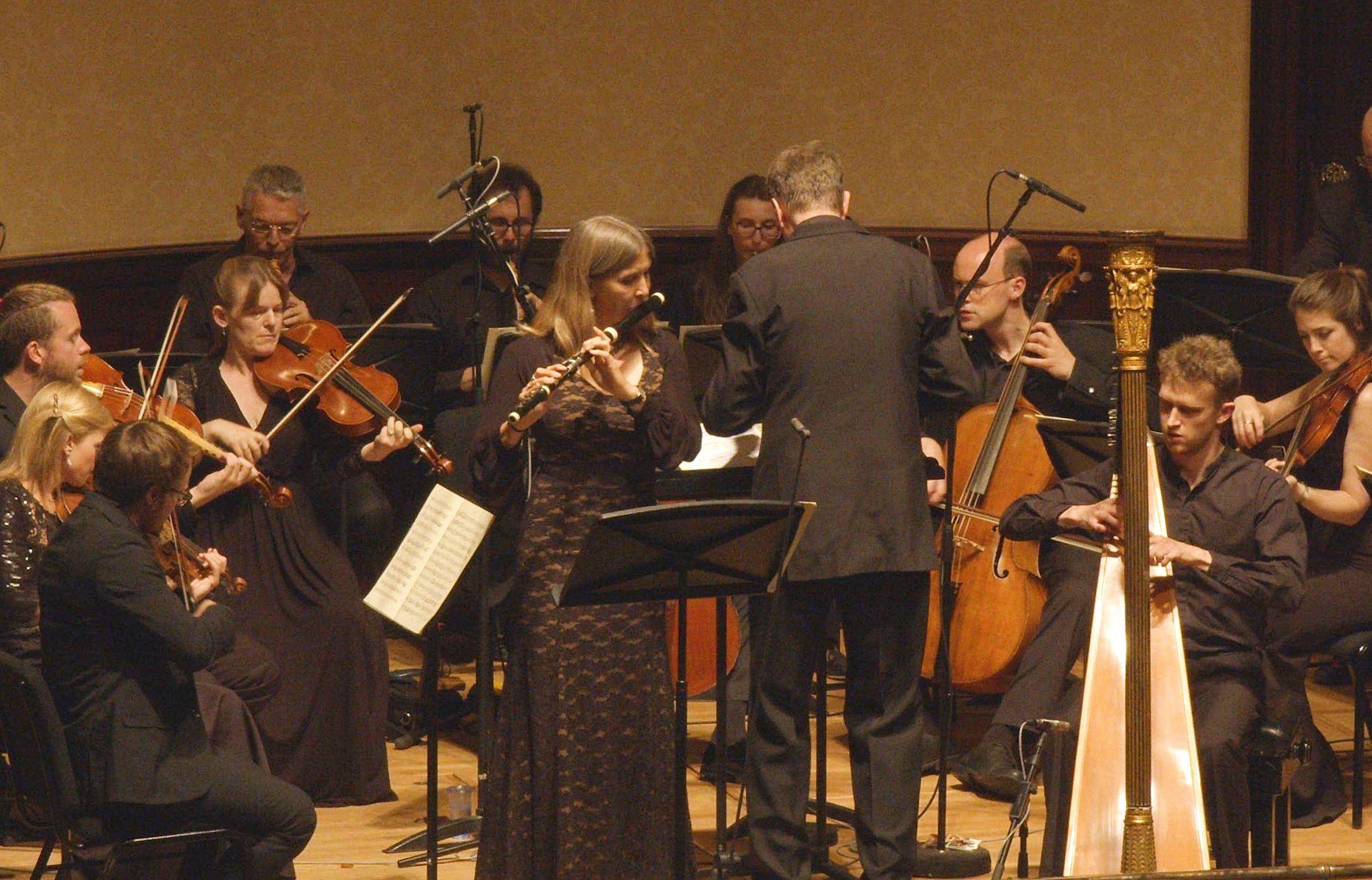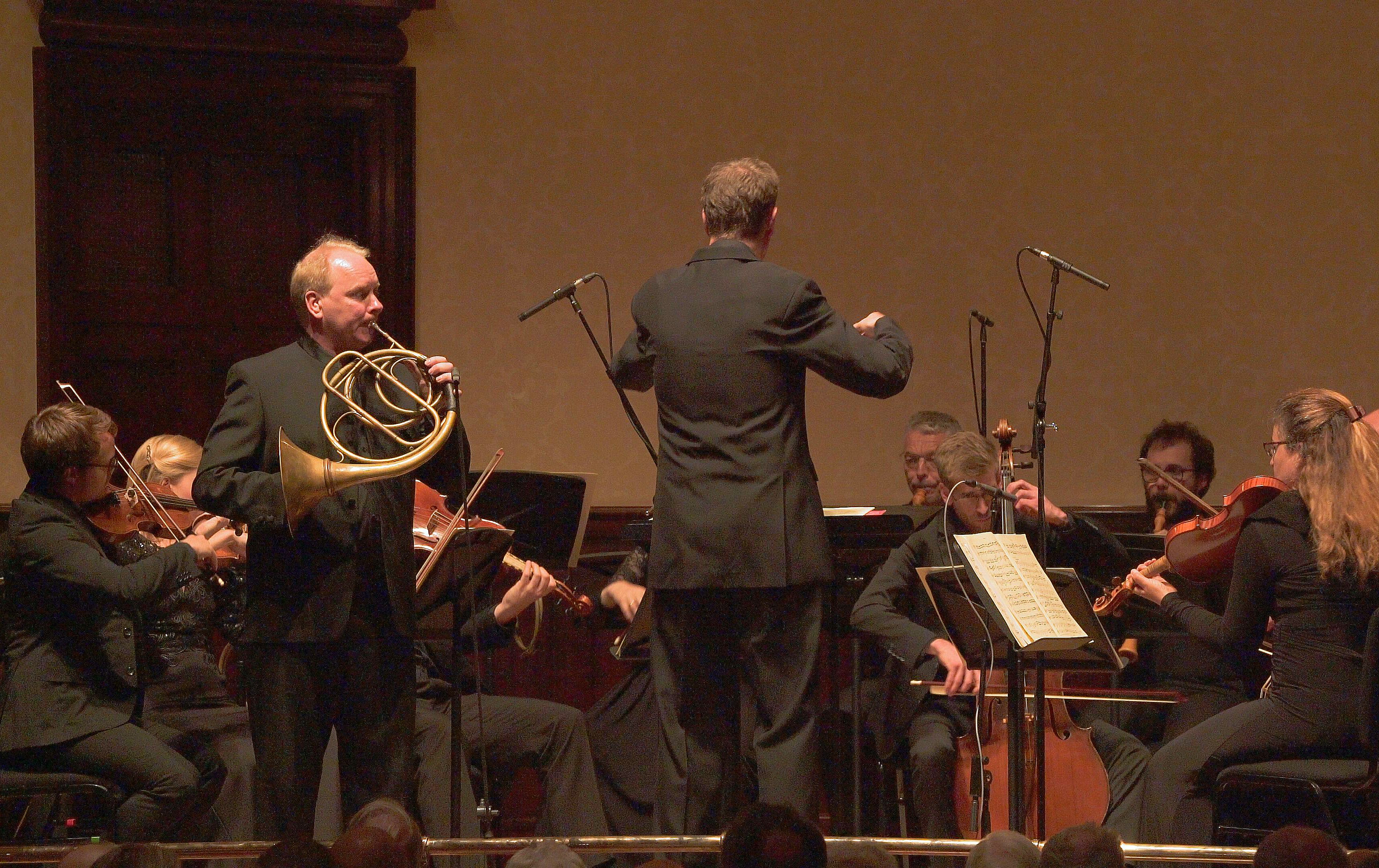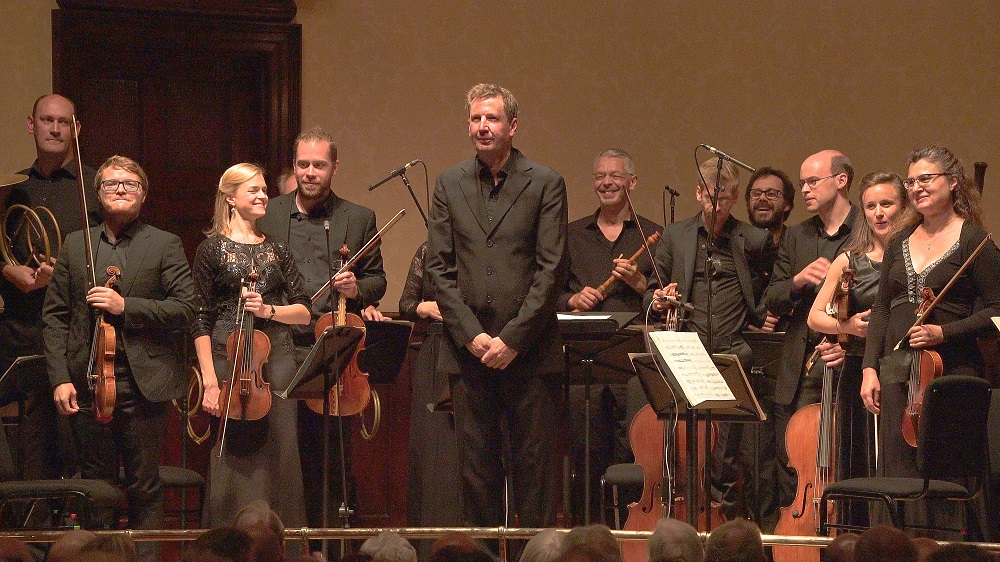Alder, The Mozartists, Page, Wigmore Hall review - a Mozart feast for eyes and ears | reviews, news & interviews
Alder, The Mozartists, Page, Wigmore Hall review - a Mozart feast for eyes and ears
Alder, The Mozartists, Page, Wigmore Hall review - a Mozart feast for eyes and ears
Period-instrument thrills and a state-of-the-art soprano

Seven European cities, seven works: from an eight-year-old's First Symphony composed in what is now Ebury Street to the towering concert aria for Josepha Dushchek of Prague's Villa Bertramka, Ian Page's latest Mozart cornucopia took us on a rich and at times startling journey, a testament - as Page wrote eloquently yesterday in his article for The Arts Desk - to the abiding need for
If there was a flaw, it came in the inevitable grouping of pretty but hardly ground-breaking numbers in the first half - and if I disagree with Page over anything at all, it's in the equation of precocity with early genius: the latter belongs to Schubert and Mendelssohn, while Mozart hit it in his early 20s. Nevertheless the (very) early symphony (K.16) contains a surprise within its very brief final Presto, and so does No. 10 (K. 74), taking us back to young Mozartino at the end of he concert after the astonishment of the rest of the music after the interval. Page's strings, led here with visible esprit by James Toll, are always keenly sprung and dynamically nuanced, even if there were a few woodwind intonation problems at the beginning, to be expected from period instruments.  In any case two of those lent a very specific colour from two of the soloists in the evening's concertos (I can't guess the provenance of the third, Oliver Wass's subtle and distinctive harp). A wooden flute, cooing like a wood dove, is very different from today's more piercing models, and Katy Bircher made subtle but always audible work of her well-distributed role in the Flute and Harp Concerto composed for Parisian tastes. It's a tour de force of Mozart's practical work with unconventional forces, and the harp especially takes a surprising melodic lead in the Rondeau, the movement you'd think would be least adaptable to such forces, allowing us to hear the exquisite artistry of Wass (pictured above with Bircher and the ensemble). Easy listening - you would hardly expect the two solo instruments to plumb poignant depths, at least not until Debussy and Ravel wrote for them - was offset by the sheer joy of watching as well as listening.
In any case two of those lent a very specific colour from two of the soloists in the evening's concertos (I can't guess the provenance of the third, Oliver Wass's subtle and distinctive harp). A wooden flute, cooing like a wood dove, is very different from today's more piercing models, and Katy Bircher made subtle but always audible work of her well-distributed role in the Flute and Harp Concerto composed for Parisian tastes. It's a tour de force of Mozart's practical work with unconventional forces, and the harp especially takes a surprising melodic lead in the Rondeau, the movement you'd think would be least adaptable to such forces, allowing us to hear the exquisite artistry of Wass (pictured above with Bircher and the ensemble). Easy listening - you would hardly expect the two solo instruments to plumb poignant depths, at least not until Debussy and Ravel wrote for them - was offset by the sheer joy of watching as well as listening.
That was even more so the case in the Fourth Horn Concerto, pace Flanders and Swann's celebrated texting of the finale not in any way a lost cause on a natural (ie valveless) instrument. For those of us who've never heard one in live action for a Mozart concerto, Gavin Edwards' rollercoaster ride (the horn-player pictured below) was exhilarating if briefly nerve-wracking. There could be four different instruments in there, so wide is the range of colours, the startling contrasts between open and stopped notes.  Cap that? Only a complete artists like our already great young soprano Louise Alder could do so, rising to the astonishing challenge of Mozart's 1787 concert aria "Bella mia fiamma...Resta, o cara" with the gamut of expressions and full tone from top to bottom of a demanding range (in the confines of the Wigmore, it sounds as if dramatic is being added to lyric perfection in the voice).
Cap that? Only a complete artists like our already great young soprano Louise Alder could do so, rising to the astonishing challenge of Mozart's 1787 concert aria "Bella mia fiamma...Resta, o cara" with the gamut of expressions and full tone from top to bottom of a demanding range (in the confines of the Wigmore, it sounds as if dramatic is being added to lyric perfection in the voice).
She came to it across the evening by gentler approaches - the historically interesting (Mozart's first surviving accompanied recitative) but musically generic "Per quel paterno amplesso", then Ilia's utterly bewitching "Se il padre perdei" from the first operatic masterpiece, Idomeneo. Here Mozart, quite apart from setting the sentiments of the troubled Trojan refugee so sensitively, goes further than any composer before him in generous writing for the woodwind in an operatic context - by giving them an extra couple of turns in the coda, he seems reluctant to let them go.  As Page points out, "Resta, o cara" includes the dizzying inclusion of a melodically memorable tone row (all 12 notes, to be flashed up again in the different context of the Fortieth Symphony). Not the first - needless to say, Bach had been there already in his B minor Fugue - but a deeply enriching addition to the most expressive of settings. It needs artists working at this kind of level; Page's choice of players and singers - including, next season, another young soprano following in Alder's footsteps, Samantha Clarke - promises us further riches across the many Mozart years to come.
As Page points out, "Resta, o cara" includes the dizzying inclusion of a melodically memorable tone row (all 12 notes, to be flashed up again in the different context of the Fortieth Symphony). Not the first - needless to say, Bach had been there already in his B minor Fugue - but a deeply enriching addition to the most expressive of settings. It needs artists working at this kind of level; Page's choice of players and singers - including, next season, another young soprano following in Alder's footsteps, Samantha Clarke - promises us further riches across the many Mozart years to come.
rating
Explore topics
Share this article
The future of Arts Journalism
You can stop theartsdesk.com closing!
We urgently need financing to survive. Our fundraising drive has thus far raised £49,000 but we need to reach £100,000 or we will be forced to close. Please contribute here: https://gofund.me/c3f6033d
And if you can forward this information to anyone who might assist, we’d be grateful.

Subscribe to theartsdesk.com
Thank you for continuing to read our work on theartsdesk.com. For unlimited access to every article in its entirety, including our archive of more than 15,000 pieces, we're asking for £5 per month or £40 per year. We feel it's a very good deal, and hope you do too.
To take a subscription now simply click here.
And if you're looking for that extra gift for a friend or family member, why not treat them to a theartsdesk.com gift subscription?
more Classical music
 Anja Mittermüller, Richard Fu, Wigmore Hall review - a glorious hall debut
The Austrian mezzo shines - at the age of 22
Anja Mittermüller, Richard Fu, Wigmore Hall review - a glorious hall debut
The Austrian mezzo shines - at the age of 22
 First Person: clarinettist Oliver Pashley on the new horizons of The Hermes Experiment's latest album
Compositions by members of this unusual quartet feature for the first time
First Person: clarinettist Oliver Pashley on the new horizons of The Hermes Experiment's latest album
Compositions by members of this unusual quartet feature for the first time
 Gesualdo Passione, Les Arts Florissants, Amala Dior Company, Barbican review - inspired collaboration excavates the music's humanity
At times it was like watching an anarchic religious procession
Gesualdo Passione, Les Arts Florissants, Amala Dior Company, Barbican review - inspired collaboration excavates the music's humanity
At times it was like watching an anarchic religious procession
 Classical CDs: Camels, concrete and cabaret
An influential American composer's 90th birthday box, plus British piano concertos and a father-and-son duo
Classical CDs: Camels, concrete and cabaret
An influential American composer's 90th birthday box, plus British piano concertos and a father-and-son duo
 Cockerham, Manchester Camerata, Sheen, Martin Harris Centre, Manchester review - re-enacting the dawn of modernism
Two UK premieres added to three miniatures from a seminal event of January 1914
Cockerham, Manchester Camerata, Sheen, Martin Harris Centre, Manchester review - re-enacting the dawn of modernism
Two UK premieres added to three miniatures from a seminal event of January 1914
 Kempf, Brno Philharmonic, Davies, Bridgewater Hall, Manchester review - European tradition meets American jazz
Bouncing Czechs enjoy their Gershwin and Brubeck alongside Janáček and Dvořák
Kempf, Brno Philharmonic, Davies, Bridgewater Hall, Manchester review - European tradition meets American jazz
Bouncing Czechs enjoy their Gershwin and Brubeck alongside Janáček and Dvořák
 Solomon, OAE, Butt, QEH review - daft Biblical whitewashing with great choruses
Even a top soprano and mezzo can’t make this Handel paean wholly convincing
Solomon, OAE, Butt, QEH review - daft Biblical whitewashing with great choruses
Even a top soprano and mezzo can’t make this Handel paean wholly convincing
 Two-Piano Gala, Kings Place review - shining constellations
London Piano Festival curators and illustrious friends entertain and enlighten
Two-Piano Gala, Kings Place review - shining constellations
London Piano Festival curators and illustrious friends entertain and enlighten
 Echo Vocal Ensemble, Latto, Union Chapel review - eclectic choral programme garlanded with dance
Beautiful singing at the heart of an imaginative and stylistically varied concert
Echo Vocal Ensemble, Latto, Union Chapel review - eclectic choral programme garlanded with dance
Beautiful singing at the heart of an imaginative and stylistically varied concert
 Scott, Irish Baroque Orchestra, Whelan, RIAM, Dublin review - towards a Mozart masterpiece
Characteristic joy and enlightenment from this team, but a valveless horn brings problems
Scott, Irish Baroque Orchestra, Whelan, RIAM, Dublin review - towards a Mozart masterpiece
Characteristic joy and enlightenment from this team, but a valveless horn brings problems
 Classical CDs: Voice flutes, flugelhorns and froth
Baroque sonatas, English orchestral music and an emotionally-charged vocal recital
Classical CDs: Voice flutes, flugelhorns and froth
Baroque sonatas, English orchestral music and an emotionally-charged vocal recital

Add comment